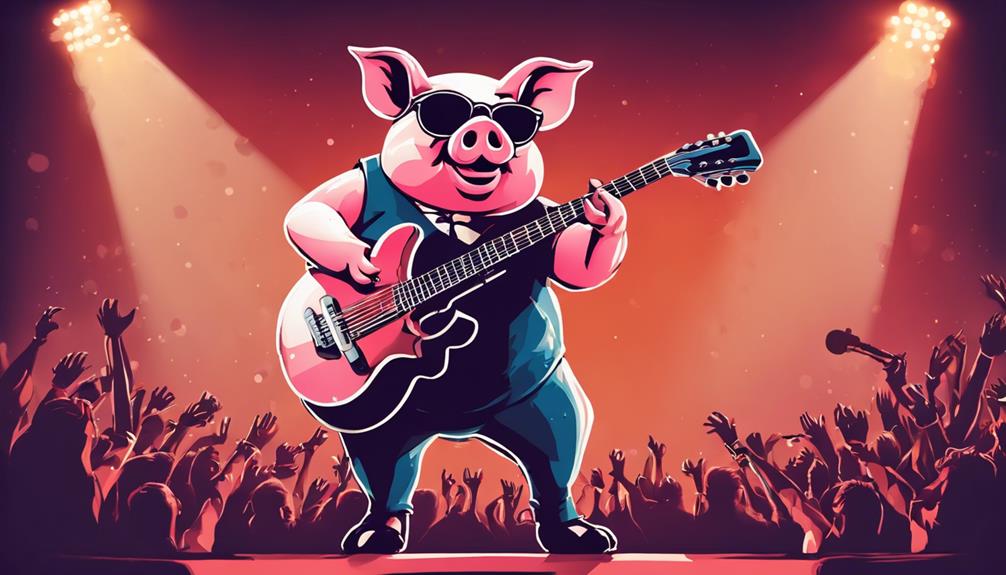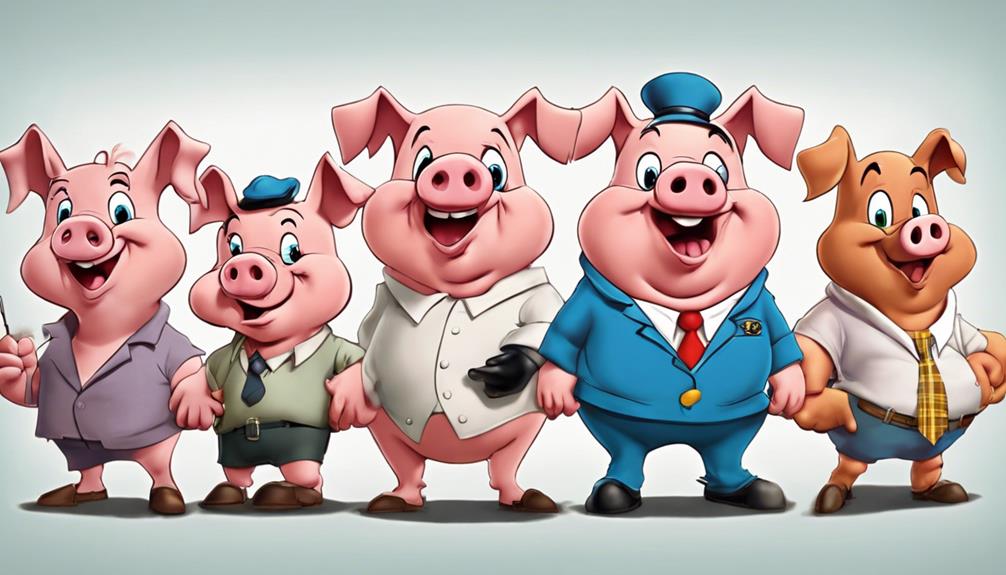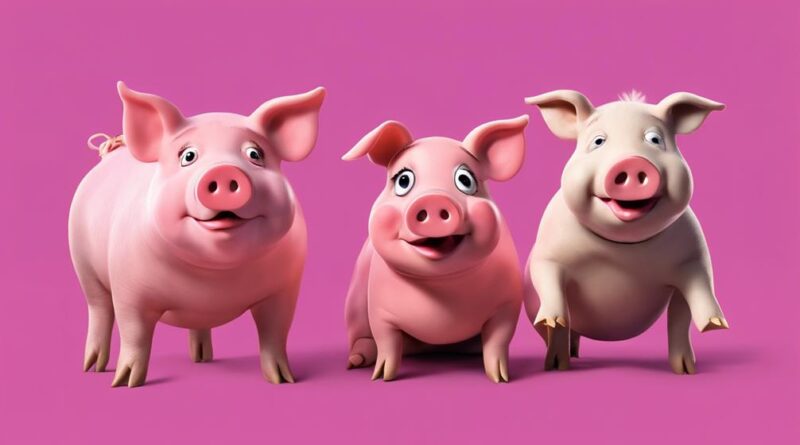6 Best Representations of Pigs in Cultural Media
When considering the most intriguing portrayals of pigs in cultural media, one cannot help but acknowledge the diverse and fascinating ways in which these creatures have been depicted across various forms of artistic expression.
From classic literature to modern television, pigs have held a significant place in our collective imagination. Each representation offers a unique perspective on these often underestimated animals, shedding light on their symbolic significance and cultural relevance.
Explore these six best representations to uncover the depth and richness of pig depictions in cultural media.
Classic Pig Characters in Literature
When exploring classic pig characters in literature, you'll uncover a diverse range of personalities and roles these iconic figures play in storytelling. Pig protagonists often take center stage, showcasing qualities like bravery, wit, and resilience. One of the most famous pig protagonists is Wilbur from E.B. White's 'Charlotte's Web.' Wilbur's journey from a vulnerable piglet to a cherished friend is heartwarming and teaches valuable lessons about friendship and selflessness.
In contrast, pig sidekicks serve as loyal companions to the main characters, offering comic relief and unwavering support. An excellent example of a pig sidekick is Napoleon from George Orwell's 'Animal Farm.' Although not the central character, Napoleon's cunning and manipulative nature propel the story forward, highlighting the complexities of power and corruption.
Pigs in literature often symbolize various themes and ideas, ranging from innocence and purity to greed and deception. Through pig protagonists and sidekicks, authors bring depth and nuance to their narratives, captivating readers of all ages. Whether they're embarking on thrilling adventures or navigating intricate moral dilemmas, pig characters leave a lasting impact on literary works, reminding us of the multifaceted nature of storytelling. So, next time you delve into a book featuring a pig character, pay attention to the nuances of their personalities and the vital roles they play in shaping the narrative landscape.
Pigs in Animated Films
Exploring the vibrant world of animated films, you encounter a multitude of endearing and memorable pig characters that bring joy and entertainment to audiences of all ages. From pig protagonists to animated pig sidekicks, these films showcase the versatility and charm of pigs in storytelling. Here are some notable representations:
- Pig Protagonists: Animated films often feature pigs as the main characters, showcasing their intelligence, humor, and relatability. Films like 'Charlotte's Web' and 'Piglet's Big Movie' highlight the courage and heart of pig protagonists, endearing them to viewers young and old.
- Animated Pig Sidekicks: Pigs also shine as sidekicks in animated films, providing comic relief and loyalty to the main characters. Characters like Pua from 'Moana' and Hamm from 'Toy Story' add depth and humor to the storylines, proving that pig sidekicks can be just as memorable as the leads.
- Cultural Representation: Animated films featuring pigs often incorporate cultural elements related to pigs, such as their symbolism in different societies. This adds layers of meaning to the characters and storylines, making them more enriching and educational for audiences.
- Evolution of Pig Characters: Over the years, pig characters in animated films have evolved in their portrayal, breaking stereotypes and offering fresh perspectives on these lovable animals. This evolution reflects changing attitudes and values in society, making pig characters more relevant and impactful in modern storytelling.
Symbolism of Pigs in Art
In examining the representation of pigs in art, one can uncover the rich symbolism associated with these animals across various cultural and artistic contexts. Pigs hold significant cultural significance and have been subject to diverse artistic interpretations throughout history. The pig symbolism in art often goes beyond the mere visual representation of the animal itself; it delves into deeper layers of meaning that reflect societal values, beliefs, and perceptions.
Across different cultures, pigs have been depicted in art to symbolize various concepts such as prosperity, abundance, fertility, and even greed or gluttony. Artists have used pigs as a metaphor to convey complex ideas and emotions, drawing on the animal's characteristics and behaviors to create powerful visual narratives. From classical paintings to modern sculptures, the artistic interpretation of pigs has evolved over time, reflecting changing attitudes towards these animals.
In art, pigs aren't merely portrayed as farm animals but as symbols that carry layers of meaning waiting to be deciphered by the viewer. Whether appearing in religious paintings, mythological scenes, or contemporary artworks, the pig serves as a versatile symbol that sparks contemplation and discussion. By exploring the pig symbolism in art, one can gain a deeper understanding of the cultural contexts in which these representations emerge, shedding light on the intricate relationship between humans and these intelligent creatures.
Pigs in Mythology and Folklore
Have you ever wondered about the captivating tales and mythical significance surrounding pigs in various cultures worldwide? Pigs have played a significant role in mythology and folklore across different societies, symbolizing various concepts and beliefs. Here are some intriguing aspects of pigs in mythology and folklore:
- Pig symbolism in religion: In many cultures, pigs are seen as symbols of fertility, abundance, and prosperity. For example, in ancient Egyptian mythology, the pig was associated with the goddess Isis, representing motherhood and the cycle of life. In some Native American traditions, the pig symbolizes courage and protection.
- Folklore pig tales: Folklore is rich with stories featuring pigs as central characters. One famous tale is the story of the Three Little Pigs, a popular European folktale that has been adapted into various versions worldwide. These tales often portray pigs as clever and resourceful animals who outsmart their adversaries.
- Sacred pig rituals: In certain cultures, pigs hold sacred significance and are involved in rituals and ceremonies. For instance, in Hinduism, the boar is considered an avatar of the god Vishnu and is worshipped during festivals like Varaha Jayanti.
- Transformation symbolism: Pigs are sometimes associated with transformation and rebirth due to their connection with cycles of life and death. In Chinese mythology, the pig is one of the 12 animals of the Chinese zodiac, representing wealth and good fortune.
These examples showcase the diverse and fascinating roles that pigs play in mythology and folklore around the world.
Pigs in Popular Music

Pigs have made their mark in popular music, influencing lyrics and album art across various genres. From iconic rock bands to contemporary pop stars, musical pigs have been a source of inspiration for artists worldwide. Some artists have even dedicated entire songs to these fascinating animals, creating pig-inspired songs that have resonated with audiences.
For instance, the band Pink Floyd featured a flying pig on the cover of their album 'Animals,' symbolizing societal issues. The song 'Pigs (Three Different Ones)' from the same album, uses pigs metaphorically to represent different types of people in society. This iconic album art and lyrical content showcase the depth and creativity that pig references can bring to music.
In a completely different genre, the children's song 'Old MacDonald Had a Farm' features a pig as one of the animals on the farm, highlighting pigs' presence even in music targeted at young audiences. This simple yet effective inclusion of pigs in music demonstrates their universal appeal and recognition across various age groups.
Pig References in Pop Culture
Occasionally, cultural references to pigs can be found in various forms of entertainment and media. When it comes to piggy fashion trends, you might notice cute pig-shaped accessories like earrings or handbags making a stylish statement. Pig-themed memes, on the other hand, have taken the internet by storm, with funny images or videos featuring pigs in humorous situations spreading rapidly across social media platforms.
To delve deeper into the world of pig references in pop culture, consider these four intriguing points:
- Piggy Fashion Trends: Keep an eye out for the latest pig-inspired clothing lines that blend comfort with a touch of whimsy, showcasing adorable pig prints on t-shirts, hoodies, and even socks.
- Pig Themed Memes: Explore the vast realm of pig-themed memes that range from hilarious puns to heartwarming illustrations, offering a delightful escape from everyday stresses.
- Celebrity Pig References: Discover how celebrities use pig references in their work, whether it's incorporating pig imagery in music videos or sharing their love for pigs on social media platforms.
- Piggy Pop Culture Icons: Uncover how certain pig characters in movies, TV shows, or books have become beloved pop culture icons, leaving a lasting impression on audiences worldwide.
These elements collectively contribute to the rich tapestry of pig references in pop culture, showcasing the enduring charm and versatility of these lovable animals.
Evolution of Pig Characters in TV

Delving into television history, pig characters have undergone significant evolution, reflecting changing cultural attitudes and storytelling trends. Initially, pig characters in TV shows were often portrayed as comedic sidekicks or farm animals with limited depth. However, as television evolved, so did the portrayal of pig personalities. They began to be depicted as complex, multi-dimensional characters with their own hopes, dreams, and struggles, resonating with audiences on a deeper level.
This evolution in pig characters on TV has had a profound cultural impact. Shows like 'Piggy and Friends' and 'Porky's Adventures' introduced pig characters that challenged stereotypes and showcased a wide range of emotions and experiences. These representations not only entertained audiences but also helped challenge preconceived notions about pigs in society.
As TV storytelling techniques advanced, so did the complexity of pig characters. Writers began to explore themes of friendship, family, and personal growth through the lens of pig protagonists, making them relatable to viewers of all ages. This shift in portraying pig personalities allowed for more nuanced storytelling and deeper connections with audiences, further solidifying the place of pigs in TV as beloved and memorable characters.
Pigs in Modern Literature
In contemporary literary works, the portrayal of swine characters has evolved to reflect deeper themes and complexities, enriching the narrative landscape. Pig symbolism in contemporary novels delves into profound allegories and societal reflections. These creatures are no longer merely farm animals but embodiments of greed, innocence, or transformation.
When exploring pig characters in modern poetry, poets often use these animals as metaphors for human experiences. Pigs might symbolize resilience in the face of adversity or the struggle against societal expectations. In this way, poets infuse depth and emotion into their verses, inviting readers to contemplate the human condition through the lens of these creatures.
- Pig Symbolism in Contemporary Novels: Swine characters in modern novels serve as multifaceted symbols, representing various aspects of human nature and society. Authors leverage the characteristics of pigs to convey deeper meanings and provoke thought.
- Pig Characters in Modern Poetry: Poets utilize pig imagery to evoke powerful emotions and convey complex themes. Through poetry, these animals come to life as poignant symbols, resonating with readers on a profound level.
Frequently Asked Questions
How Do Pigs Compare to Other Animals in Terms of Representation in Cultural Media?
When looking at how pigs compare to other animals in cultural media, consider their symbolism and societal impact. Pigs have been represented in various ways, influencing media portrayals. Their versatile nature allows for a range of interpretations, from cute and cuddly characters to symbols of greed or intelligence.
This diversity in representation showcases the multifaceted nature of pigs and their ability to impact societal views through cultural media.
Are There Any Significant Differences in the Portrayal of Pigs in Western Versus Eastern Cultural Media?
In Western cartoons, pigs often appear as cute and comedic characters, while in Eastern folklore, they can symbolize prosperity and luck. Cultural differences play a significant role in shaping how pigs are portrayed in media.
Pigs in Western media may be more anthropomorphized and used for humor, while in Eastern media, they may have deeper symbolic meanings tied to tradition and beliefs. These contrasting representations reflect unique cultural perspectives on pigs.
What Role Do Pigs Play in Children's Literature Compared to Adult Literature?
In children's literature, pigs often symbolize innocence and curiosity, featuring in stories about friendship and adventure. They're portrayed as lovable and endearing characters that teach valuable life lessons.
In contrast, adult fiction tends to explore deeper themes through pigs in folklore, using them as symbols of greed or gluttony. Pigs in media reflect societal values and beliefs, highlighting their adaptability as symbols in different contexts.
Are There Any Notable Instances of Pigs Being Portrayed as Villains in Cultural Media?
When it comes to piggy villains in cultural media, there are some notable instances. Evil swine characters have often been portrayed as cunning and devious, perpetuating stereotypes about pigs being conniving and greedy.
These portrayals have had a significant cultural impact, reinforcing negative perceptions of pigs in some narratives. From classic literature to modern film, the image of pigs as antagonists has been a recurring theme, shaping how they're viewed in popular media.
How Have Advancements in Technology Influenced the Portrayal of Pigs in Modern Cultural Media Compared to Traditional Forms of Media?
In modern cultural media, technological advancements have greatly influenced the visual representation of pigs compared to traditional forms.
With the use of CGI and advanced animation techniques, pigs can now be depicted in more lifelike and expressive ways.
These tools have allowed for a broader range of emotions and characteristics to be portrayed, enhancing the complexity and depth of pig characters in modern storytelling.
Conclusion
In conclusion, pigs have been portrayed in various forms of cultural media throughout history. From classic literature to animated films, art, mythology, music, and pop culture, these representations showcase the versatility and symbolism of pigs in different contexts. They highlight the significance of pigs in human culture, whether as lovable characters or symbolic figures. Pigs continue to captivate audiences and leave a lasting impact on our collective imagination.
